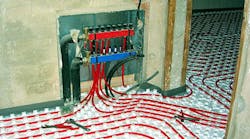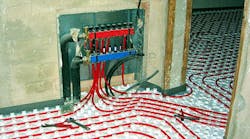Last month, we continued a series of columns on my experiences as a former expert witness on hydronic heating systems. This is part four, the last part of that series. In the last column, we were talking about the need to look at the building plans as a “system” instead of looking at them from an individual component perspective. We are now continuing on with that conversation.
If you note on the blueprints that there are flue pipes in an adjacent bedroom wall, or that the mechanical room is directly below a sleeping area, ask the consumers how sensitive they are to noise issues at night.
There is no such thing as a virtually silent mechanical system, and people who are noise sensitive should seriously consider moving the location of the physical plant somewhere far away from sleeping quarters, or be prepared to be woken up at night by the clicking of relays, the whirring of pumps, and blower motors. There are noise attenuation/abatement experts who can make these systems very quiet, but it generally comes with a healthy price and no real guarantee of performance.
In general, many problems and potential future issues can be addressed during these meetings, and the consumer’s expectations can be taken into consideration in the balance of the design and estimation process. Please don’t find yourself getting caught in the “how much?” trap. Even in situations where the client can afford to burn money to stay warm, money is always an issue. Blurting out a number in one of these meetings is going to come back to haunt you.
The only number the consumer hears and remembers is the one you blurted out during the initial meeting. If you gave a range, the consumer only heard the lower number. It’s human nature. I always found that there is only one correct answer to any pricing question, and that universal answer is, “It depends ... Let me get back to you after doing some research.”
If they continue to press you for a price, guess high to avoid having to explain the reason it came in higher after the fact, and make certain they understand that it is a guess and not a valid number backed up with proof and evidence.
If they express shock or concern, it is the right time to explain to them that this system isn’t rocket science, that it is actually more complicated than that. Provide them with pictures of your completed systems. Give them the names and contact information of your satisfied existing customers and encourage them to reach out and contact these customers.
Also encourage them to reach out to your competition’s existing customer base. Having them do their own due diligence is to your advantage. They will be able to see the difference, and realize the value of your proposal.
And don’t forget to take care of the existing customer base. For each referral that they stand up for you on, offer them a free annual test and tune of their appliance, or a gift certificate to a local restaurant. Give value to their time and efforts. It will pay you back many times over.
And don’t forget to include the humidity control package and air treatment systems as a part of your comfort delivery system. Many times, hydronic contractors who aren’t adept at working with sheet metal exclude these provisions from their proposals. If you are like me, your hands start bleeding if you even look at sheet metal.
I learned that I could find some well-trained, professional sheet metal working contractors that I could include as a part of my overall system design, and ensure that I was in fact delivering a “full spectrum comfort package” and guarantee the clients’ overall comfort, and the longevity of wood products within the home.
Your competition is probably still stuck in the same mind-set that he too doesn’t do sheet metal work, and will exclude the air treatment packages from their bid. And when I say air treatment, I am including the need for energy and/or heat recovery ventilators and ultraviolet air treatment/filtration systems as a part and parcel of the package.
It is going to increase the cost of the system, but with today’s homes being as tight as they are, these additional air treatment systems are essential in order to guarantee the most efficient, comfortable, and healthy system that money can buy.
It is better to include the price of these options in your initial proposal, and if need be you can remove them to lower the installed price. Adding additional cost to an existing package is a turnoff to the consumer. Remember, regardless of their economic status, price is an issue. Getting reductions in installed costs just feels better than getting increases in costs.
As a member of the Radiant Professionals Alliance, you will be given the opportunity to talk about these issues with your peers. The RPA is about supporting the contractor members and the exchange of information. Join this very worthwhile organization, won’t you? Check out the classes we have to offer to at heatspring.com.
Mark Eatherton material on this website is protected by Copyright 2015. Any reuse of this material (print or electronic) must first have the expressed written permission of Mark Eatherton and CONTRACTOR Magazine. Please contact via email at: [email protected].
About the Author
Mark Eatherton
Mark Eatherton material on this website is protected by Copyright 2017. Any reuse of this material (print or electronic) must first have the expressed written permission of Mark Eatherton and CONTRACTOR Magazine.

